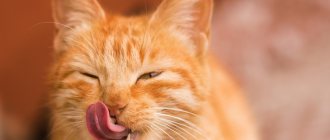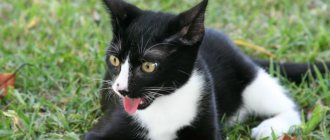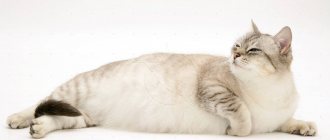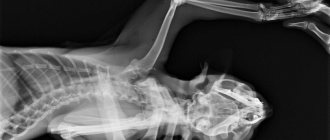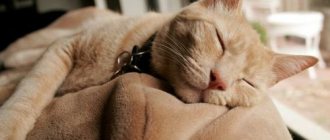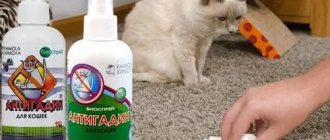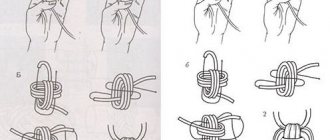Physiological reasons
In cats, as in humans, breathing through the nose is considered the physiological norm. It is not uncommon to see a cat breathing with its mouth open and its tongue hanging out like a dog. It is noticeable that with this method of breathing the abdominal muscles are involved: the cat breathes not from the chest, but from the stomach.
Nature has created a vacuum in the chest cavity around the lungs. When the pectoral muscles work while inhaling, the ribs diverge - the lungs straighten and fill with air, which enriches the blood with oxygen.
If there is a lack of oxygen, an “emergency” breathing mode is activated and the abdominal muscles are activated. The body tries to increase the amount of air inhaled - it increases breathing movements.
As soon as the oxygen level in the blood returns to normal, abdominal breathing “turns off” - the cat breathes calmly, through the chest, through the nose. If the animal does not have any pathological changes in the body, such conditions correspond to the norm and quickly pass when the negative factor is eliminated.
Natural external reasons why a cat breathes with its mouth open are:
- Hot. It is known that as the air temperature rises, the oxygen content decreases. The body's need for this element increases. The brain introduces a mode of “enhanced ventilation” - breathing becomes more frequent. Long-haired cats have a particularly hard time withstanding the heat: Maine Coons, Persians, Siberians. The owner's job is to keep the animal cool.
- Rapid breathing is often observed in cats that are obese. If a cat has suddenly gained weight, then you can often observe that the animal is breathing heavily with its mouth open. After the body adapts to the extra load or returns to normal (which is preferable), these phenomena disappear.
- After increased physical activity. Kittens are especially susceptible to this. Kids do not yet know how to regulate the load and after playing they get so tired that they “lay around without their hind legs” and often breathe with their mouths open and stick out their tongues. If the kitten breathes with an open mouth, then the reason for this may be irrepressible running and active play.
- Generic activity. During contractions and pushing, the uterus contracts, which limits the supply of oxygen to the organ. To avoid hypoxia in newborn kittens, the mother's body turns on increased breathing to protect the babies from suffocation. In this case, this is a necessary measure.
- The first time after giving birth and while feeding kittens, the cat may breathe rapidly with its mouth open, this is normal.
- Sexual hunting. During this period, the endocrine system of cats works in active mode: increased releases of sex hormones into the blood occur. Increased activity of the endocrine glands requires more oxygen - cats breathe frequently.
- Stressful situations. By frequent, heavy breathing with an open mouth, the animal’s body responds to psychological discomfort.
When these causes are eliminated, the cat quickly restores normal respiratory activity.
Diagnosis of the condition
The multiplicity of causes that can cause cat cough makes it very difficult to diagnose cats. Therefore, the veterinary specialist consistently conducts a series of studies, including:
- collection of anamnestic data;
- inspection;
- palpation;
- percussion;
- auscultation;
- general and clinical blood test;
- radiography;
- coprogram for identifying intestinal helminth eggs.
If it is not immediately possible to determine the reason why the cat cannot cough, the veterinarian will prescribe additional laboratory and instrumental tests.
Note! Only large veterinary clinics can afford additional research, and the cost of these services is quite high. Therefore, it is advisable to carry them out more often for such high-pedigreed “expensive” cats as Sphynx, Maine Coon, Peterbald, Scottish Fold and others.
Specific additional studies that will help determine exactly why a cat is coughing with wheezing include:
- sputum analysis for the presence of viral agents and their identification;
- fluoroscopy of the esophagus using a contrast indicator;
- endoscopy of the upper respiratory tract and esophagus;
- bronchoalveolar lavage (performed under general anesthesia).
If the doctor suspects that the cat cannot cough due to the development of pathology of the cardiovascular system, the doctor will prescribe an ECG or ultrasound of the heart.
Pathological causes
Rapid breathing with an open mouth and protruding tongue indicates a lack of air in the cat’s body - oxygen starvation. If the natural causes of this condition have been eliminated, and the cat continues to breathe too quickly, do not hesitate, you need to show the animal to a specialist.
The reason for this may be dangerous pathological conditions.
Pulmonary edema
When they talk about pulmonary edema, they mean excessive accumulation of fluid in the tissues of the organ. This is not an independent disease, but a symptom. In cats, pulmonary edema can develop for two reasons: cardiogenic (edema is provoked by some kind of cardiac pathology) and non-cardiogenic - caused by external influences.
Non-cardiogenic causes:
- hot air entering the respiratory tract;
- reaction to medications, including anesthesia;
- allergy;
- consequences of pneumonia or asthma;
- food poisoning or inhalation of toxic fumes;
- renal failure;
- head injury with damage to the brain and its membranes;
- blood poisoning;
- sun, heatstroke or electric shock.
Pulmonary edema develops very quickly, and if urgent rescue measures are not taken, the cat may die. This condition has pronounced symptoms and is easy to identify:
- the cat suddenly loses strength and stops responding to external stimuli;
- it is noticeable that the animal is having difficulty breathing;
- the animal coughs, breathes with its mouth slightly open, sticks out its tongue;
- mucous membranes rapidly turn pale, subsequently acquiring a bluish tint;
- when coughing, pinkish sputum appears - the result of injury to the alveoli;
- the initially rapid heartbeat weakens and becomes intermittent;
- As a result of impaired peripheral circulation, the cat's paws become cold.
Accumulation of fluid or air in the chest cavity
In case of injuries that are accompanied by damage to the skin and muscle frame or rib fractures, air can enter the cat's chest cavity. It prevents the lungs from fully expanding when inhaling. This condition is called pneumothorax.
Also, as a result of injury or internal bleeding, blood can enter the chest cavity. With various pathological conditions, there may be an accumulation of other body fluids, which interferes with the normal functioning of the cat’s lungs. This condition is called hydrothorax.
A cat can get rib fractures and penetrating wounds if it falls from a height or receives a strong blow. Only a veterinarian can determine what happened to the cat and why he is breathing with his mouth open. In case of injury, you should carefully lay the animal on its side, keep it still and urgently take it to the clinic.
State of shock
Shock is a common cause of sudden hypoxia. The threatening condition develops at lightning speed, and the following situations are the reason for its occurrence:
- injury;
- poisoning;
- allergic reaction;
- long-term infectious disease.
It is possible to bring a cat out of a state of shock only in a veterinary clinic. And if it is possible to get a shock in seconds, then getting out of it can take several days.
Foreign body in the respiratory tract
If during a meal the cat stops eating and begins to snort and cough, opens its mouth, you should watch it. Perhaps a piece of food got into the respiratory tract. He will come out soon and nothing bad will happen.
Also, during play, a small object may get into the cat’s throat.
If the cough does not stop, and wheezing is heard when breathing, and inhalation and exhalation become intermittent, do not hesitate! Probably, the foreign body has penetrated deep into the respiratory tract and can completely block it.
It is strictly forbidden to shake, turn over or slap your pet on the back or other parts of the body if the cat begins to breathe with its mouth open. These measures are unlikely to help, and are quite likely to do harm. Only a specialist can cope with the problem.
Heart diseases
Rapid and heavy breathing after games or long walks is quite normal if it is short-lived and the pet recovers quickly. If a cat breathes with her mouth open too often, and even without any particular reason, this is a cause for concern.
The appearance of a bluish tint to the tongue and oral mucosa is an alarming signal.
These signs indicate the development or presence of heart failure. Hypoxia is an inevitable companion to pathologies of cardiac activity. Urgent consultation with a feline cardiologist is necessary. The sooner the owner shows the cat to the doctor, the greater the chance of preserving the health and life of the pet.
Scottish cats, Maine Coons, Abyssinians, Orientals, Cornish Rexes and Sphynxes are especially predisposed to heart pathologies.
Other pathologies
There are a number of congenital pathologies and mechanical damage that lead to the fact that the cat is forced to breathe with his mouth open:
- pathology in the structure or damage to the spinal cord;
- brain tumors that affect the respiratory center;
- helminthic infestations: some endoparasites lay eggs in the lungs;
- respiratory diseases (bronchitis, tracheitis);
- congenital pathologies of the oral cavity.
Diagnostics
Having studied the external symptoms of cough, we proceed to diagnosis:
- conduct an external examination of the body, listen for wheezing and noises;
- evaluate cardiac activity;
- take blood for analysis;
- do an X-ray examination of the sternum;
- a culture of secretions or sputum is collected to identify the causative agent of inflammation;
- examine the affected organ for oncology (if suspected).
In clinics, it is possible to examine the entire animal’s body by different specialists and conduct an X-ray examination with a contrast agent.
First aid
In addition to the above private signs, the cat owner’s anxiety and concern should be caused by the following symptoms, common to all conditions that threaten the pet’s life:
- the cat is apathetic and lethargic;
- frequent vomiting;
- cough is dry or with bloody sputum;
- the cat shows signs of anxiety and fear.
If these symptoms are present in addition to difficulty breathing, the most effective help for your pet will be to take him to the clinic as soon as possible or call a doctor at home. During transportation or while waiting for help, the cat should be placed on its side and, if possible, its mobility should be limited.
It should be remembered that you cannot hesitate and waste time. Prolonged hypoxia entails irreversible changes in the brain, which will lead to the death of the pet.
Transporting cats to the veterinary clinic
Ten tips for transporting your cat to the veterinary clinic:
- You should never move your cat in a car unless you have a special container.
- Use a rigid container that opens from the top and front, which will allow you to perform an initial examination of the cat without removing it from the container. It is necessary to select practical and safe containers.
- Store the container in such a way that the cat perceives it as part of the interior and can get used to it.
- Make the container as comfortable and recognizable to your cat as possible by placing objects inside it that have your scent and the cat's scent (you can do this by simply rubbing a piece of cloth on the cat). Use a special spray containing pheromones (Feliwey) - spray it on the bedding material of the container at least 30 minutes before transporting the cat to the veterinary clinic. Remember that your cat may get dirty during the trip, so be sure to bring extra bedding.
- If the cat does not want to go into the container on its own, you need to carefully pick it up and carefully place it in the container on top. If this does not help and the cat is still resisting, you need to wrap it in a thick towel (either scented or treated with a pheromone spray) and then place it in a container.
- You need to place the container in the car so that it is in a stable position during the trip, placing it on the floor behind the front seat or securing it with a seat belt. Drive at a careful pace, do not listen to loud or heavy music, and talk calmly to your cat while driving. Some cats will like to see what's going on outside, but most will feel more relaxed if you cover the container with a towel during the trip.
- On the way from your car to the clinic, try not to jerk the container or knock it against your feet.
- We recommend that while waiting at the veterinary clinic, place the container so that the front of it is facing you (and not towards other pets), and cover it with a towel.
- Of course, the same transportation conditions must be true on the way back.
- Last but not least, if you have more than one cat, you will need to take some precautions when returning one of the cats to your home, especially after a long stay at the clinic. Leave the cat in the container for a few minutes and observe the reaction of the other cats. If the cats are calm, you can open the container and let the cat out. If you notice that cats are feeling tense, this may mean that the cat returning from the clinic has an unfamiliar odor. It is necessary to place it in a separate room (of course, with a toilet, food and drink) for at least 24 hours so that it acquires a more traditional smell for other cats.
Types and symptoms of cough in cats
The classification of cough in cats is described in detail in the table.
| Characteristics of cough | Degrees and types of cough manifestations |
| Force | slight cough; hacking cough |
| Form depending on duration | acute (less than 14 days); prolonged (from 14 to 45 days); chronic |
| Timbre | silent; voiced; deaf; hoarse; hoarse; barking |
| Presence of discharge | dry; wet |
| Character of sputum | serous; slimy; purulent; mixed with blood |
| Development time | constant; seasonal |
Symptoms that most often accompany coughing in cats include:
- discharge from the nasal cavity;
- vomit;
- wheezing.
The nature of the cough helps specialists make the correct diagnosis, identify the causes and prescribe appropriate treatment for a coughing cat.


